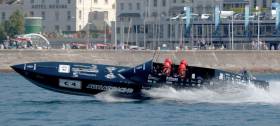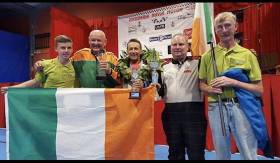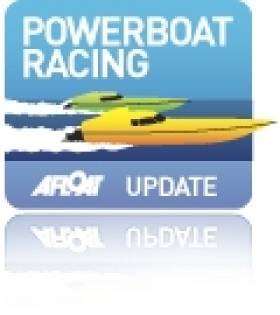Displaying items by tag: UIM
Irish Powerboat Racing Team Third at Cowes Torquay Cowes 2017 UIM Marathon
Irish powerboat racing team Allblack Racing were third overall at the Cowes Torquay Cowes 2017 UIM Marathon Powerboat. The Arklow–based team headed by John Ryan also won the best–placed non UK–crew and the best placed diesel Powered Powerboat.
It was also an honour for them as the first Irish team to have a place on the podium of this world famous Powerboat race which is in its 57th year.
Last weekend in Navia, Asturias, Spain, Hr850 and T850 Powerboat racing teams competed and represented their countries at the highest international level, the UIM World Championships. Within this group was Team Powerboat Ireland, a group of Irish Powerboat enthusiasts made up from members of North East Powerboat and Racing Club and the Irish Powerboat Racing Club.
Will Chambers (Hr850 Driver), Oliver Haire (T850 Driver) Denis Dillon (T850 Driver) Simon Haire (Crew) Dick Corley (Mechanic) veterans of previous UIM European Championships decided to pool their talents under the Banner of “Team Powerboat Ireland” and with the support of the ISA as the UIM National Authority, travel to the World Championships, represent their country and hopefully bring back UIM World Championship medals to Ireland.

The competition would not be easy as the Team found out on day 1. Will Chambers following on from his success at Navia the previous year with a UIM Silver in the European Championships was determined to follow up with a World Championship podium place. Competitive from the start he was up at the front when his race boat was holed and he had to abandon the race and lift his boat to safety. Oliver Haire also had the mechanical gremlins strike and was also lifted to safety. With no points on the score sheet for both Will and Oliver, Day 2 seemed a long way away and decisions had to be made as to what the Team would do. A Team meeting was held and a decision was made to work some long hours and repair the holed HR850 and replace the engine powerhead in the T850.
When Day two dawned, Team Powerboat Ireland were ready and with Denis Dillon having the only points on the scoresheet they knew it would be a challenge that would see man and machines pushed to the limit. And to the limit they were pushed with Will Chambers working his way up the standings with two fine second place finishes in the final heats which saw him take 3rd place overall in the HR850 Class and a UIM World Championship Bronze Medal.
There was to be no podium places for Denis Dillon and Oliver Haire but both finished in the rankings and were presented with their trophies. All were delighted that they had represented their country as best as they could and they knew they had competed against the best in the world. Plans are already afoot as to how to gain the extra edge that will see them advance in the standings for 2017.
A statement from the Team shortly after the final results:
“It’s being an amazing two days of racing, we have put blood sweat and tears into every practice, every qualifying, every race heat and we followed this up with a long evening maintaining both man and machine. During the event, we never let our passion determination and teamwork falter and for Will Chambers to achieve a UIM World Championship Bronze Medal It made the trip all worthwhile.
We knew when we left Ireland for the long journey to Spain that we would be competing against the best competitors in the world, this did not deter us and it just goes to show what a few guys with determination and Teamwork can achieve. We are very proud to have represented IRELAND on the World Stage and to bring back a “UIM World Championship Medal” in the HR850 Class is an honor and a privilege for all of us. The Team believes we have shown like our P750 racers before us what can be achieved, we feel with the right support & sponsorship, Irish Powerboat Racing Teams & Clubs working together can ensure that Team Ireland competes in UIM European & World Championships into the future, in regard to our UIM Medals we hope they are many more to come.”
Irish Powerboat Racers Take to World Stage
Irish powerboat racers have taken to the world stage in the southern hemisphere for the first time. (SCROLL DOWN FOR PHOTOS)
Keith Plummer, Lee Casey and Colin Gaffney from Dublin, all members of the Buccaneer Powerboat Club and Sean Dillon and Gary Hogg from Clare, members of the Irish Offshore Powerboat Racing Club took part in the UIM P750 World Championships South Africa last week.
On the ground the reports were that even though the Irish competitors had their mechanical setbacks they kept pushing hard. When it came to the rough stuff in the surf they really shined, gaining a lot of respect from their fellow competitors.
Sean Dillon & Gary Hogg had two wins and a second in the surf discipline and finished fourth overall in the championships. Mechanical setbacks denied Colin Gaffney and co-driver Bongani Ndesi, a world Championship medal to accompany his European Championship medal won at the UIM P750 European Championship at Killaloe in October.
All five have reported that it was a great experience and that taking part showed them what a wonderful sport this is and being part of the UIM family. They all said how proud they were to be Irish and the first competitors with an ISA Powerboat Racing Licence to Race in South Africa.
The P750 class has gone from strength to strength in Ireland and 2010 saw a well-supported national Championship, the P750 Europeans being held in Ireland and Irish Competitors competing in the World Championships.
Pictures below by Paul Bedford/www.actionimages.co.zaColin Gaffney Boat No 21, Keith Plummer and Lee Casey From Dublin Boat No 22, Sean Dillon and Gary Hogg from Clare Boat No 49. Sean and Gary were the top Irish team being placed fourth.
Union Internationale Motonautique - International Powerboat Racing Club
Union Internationale Motonautique (UIM) – International Powerboat Racing Club

History of the UIM
Though it bore little similarity to our modern sport, powerboat racing can reliably trace its origins as far back as 1902 when the British formed their Marine Motoring Association. By the following year, New York´s Columbia Yacht Club had formulated a constitution for what ultimately became the American Power Boat Association and the French had formed their Congress of Automobile Boats. In 1903, the French ran a 62 mile circuit race on the Seine at Meulan and the 230 mile Paris to Trouville event while the following year saw a race across the English Channel and an attempt to promote a Trans-Atlantic marathon.
Gottlieb Daimler had been experimenting with single cylinder internal combustion engines in Germany and America´s E.W. Graef developed what may well have been the first deep-v powerboat in the same year that Britain´s newspaper magnate, Sir Alfred Harmsworth, created what has become the world´s oldest and arguably most famous powerboat racing trophy. In 1907, a small group of motoring enthusiasts had formed the Paris based Internationale Motor Yacht Association and after a change of name to the Association Internationale du Yachting Automobile in 1908, staged races regularly in Nice, Palermo, Monte Carlo, Algiers, Toulon and Arcachon until the outbreak of the First World War. Led by the Duke of Westminster, Lord Montagu, Baron Henri de Rothschild, Noel Robbins and others, racing prospered in Europe and by 1911, the Americans had clambered in on the act by staging a race from Long Beach to Catalina Island in California.
Contested mostly in boats with vertical stem and flat bottoms which relied more on brute force and ignorance than hydrodynamic efficiency, the rich and famous took their pleasures on the water quite seriously, in an amateur sort of way The involvement of Sir Thomas Sopwith in England and Jack Manson and Gar Wood on the American scene brought a more professional edge to this emerging competition and the Harmsworth Trophy and Gold Cup competitions sparked the public imagination in much the same way as the Schneider Trophy international air races and the latterday Hales Trophy for the Trans-Atlantic Blue Riband did
By 1917, the Americans were running ten races a year in locations from Miami to Key West, Palm Beach, Havana and New York but the vagaries and traumas of changing presidents and offices almost annually with its attendant inefficiency had led to the collapse of the European AIYA in 1918, when its last known President, a Dr.Busley from Berlin, had disappeared and taken the records of the Association with him into obscurity
It was in 1922 and largely due to the lobbying efforts of an Englishman, Dr. Morton Smart and John Ward, an expatriot Irishman living in Belgium, that saw the formation in Brussels of the precursor of today´s modern administration in the new Union Internationale du Yachting Automobile with Ward as its first Secretary General and the Belgian businessman, Alfred Pierrard, its first President. Having been successful in re-establishing the international authority, Ward was succeeded as Secretary General in 1925 by Maurice Pauwaert who together with the President, administered the emergent sport unchallenged for twenty years until the outbreak of the Second World War.
By 1927 it had acquired a permanent administrative base, had promulgated its first sporting rules, published its first racing calendar and after a further change of name to the now familiar Union Internationale Motonautique, was ready to welcome more nations into its fold. Among that first intake were Argentina, Belgium, France, Germany United Kingdom, Holland, Ireland, Monaco, Norway Poland, Sweden and finally the United States of America, as the world basked in what was to be only a temporary peace.
Inevitably the Second World War brought an end to all marine sporting endeavours, though it was coincidentally responsible for much of the technical development which gave the modern sport its direction, particularly in the areas of hull and engine design but in 1946, the UIM emerged unscathed from the hostilities to meet a world of change. With its administrative base relocated from Brussels to Ghent, Freddy Buysse was elected to the President´s chair and first with Maurice Pauwaert and latterly with Henri Thomas as Secretary General, drove the UIM through its most formative decades and towards a body which is recognisable today.
The formation of a Technical Committee and the sanctioning of the American Power Boat Association to represent the nation with the biggest potential for competitive growth began a progressive programme of sporting, technical administration and safety development which continues still. Overseeing this have been successive Presidents from Italy (Vittore Catella), France, (Claude Bouilloux Lafont), Italy again, (Francesco Cosentino), Belgium, (Paul Lamberts) and currently Germany whose Ralf Frohling was elected to office in 1987. A successful hydroplane driver, the current incumbent divides his time between the sport´s top office and running a dynamic business involved in the design and production of toys and is no mean cook in his own kitchen.
Thomas retired as Secretary General in 1972 to be succeeded by the urbane Belgian, José Mawet, under whose guidance the administrative office moved from Brussels to the Principality of Monaco, and most recently, by Régine Vandekerckhove, who currently occupies the position. In late 1992, she became only the fifth person to hold this office and she is the first to admit that there is no logical career progression to groom her or anyone else for this unique and very public task.
Born in Belgium, she studied Human Sciences and Modern Languages before joining OMC Europe to assist in marketing their performance products and latterly, was instrumental in administering their support of Formula 3. Fluent in four languages with a strong bias towards marketing and communication and best known for her cheerful sense of humour, she has brought to the job a strictly hands-on administrative approach which has paid handsome dividends.
So much for the factual history of the UIM but what of the sport´s administration today? The hub of the Union, clearing house for all contacts with and from its member nations, a total now risen from twelve in 1927 to fifty-seven in 1997, and distribution centre for all relevant documentation, is its registered office within Monaco´s Stade Louis II permanent sporting complex in Font Vieille. This small suite of offices is staffed by the UIM´s permanent full-time Secretary General and two administrative assistants.
Every other office, function and activity within this international governing body is contributed on a voluntary basis by the individuals concerned and for the most part, expenses by the national authorities from which these individuals come, though some choose to fund their own activities to the wider benefit of all. The ultimate authority in the sport is vested in the UIM´s General Assembly which is made up of one delegate from each sanctioned national authority and the General Assembly meets once annually in the spring of the year, to ratify the minutes of the previous year´s Annual General Meeting and examine the reports of the General Secretary and Treasurer. In recent years and indicative of the wider ranging interests of the UIM, the location of the AGM has been alternated between Monte Carlo and Miami and Tokyo, a precedent now established.
Responsible to the General Assembly for the management of the UIM is the Central Committee, made up currently of the President and a minimum of five members, which meets as often as necessary to ensure the smooth running of the Union. In practice however, as many as twelve Administrators, Commission heads and other officers are seconded to the Committee. It is this body which appoints the permanent Secretary General, a non-voting, exofficio member of all Committees and Commissions who heads up the Union´s administrative and personnel department.
If the General Assembly is the supreme authority and the Central Committee is the power base of the UIM, it is the Commissions which make the sport work. It is the elected representatives of these Commissions from Offshore (COMINOFF), Medical and Safety (COMINSAFE), Sports (COMINSPORT), Formula, Technical (COMINTECH), Aquabike, Pleasure Navigation to Conciliation and Arbitration (COMCONA) who formulate, regulate and police the rules of competition. At any one time, it is possible to have more than 100 enthusiastic individuals voluntarily giving their time to the task of making powerboat racing sport safer and more effective.
It is within the last decade that the UIM has grown most and part of the onus for this must fall on the proliferation of racing driven jointly by the Union and its various independent promoters. Most notably this has seen racing extend its horizons to encompass China, Cuba, Abu Dhabi, Dubai, Greece, Hungary Jordan, Kuwait, Malaysia, Malta, Russia, South Africa, Thai-land and Yugoslavia and the growth is likely to continue.
In the face of geographical growth, financial pressure and the quest for media exposure, the UIM has the taxing task of presiding over a sport whose roots are firmly bedded in amateurism but which by its very nature is being progressively enveloped by professionalism at all levels. As it sets out for the next millenium and its own centenary the UIM is committed to protect its past but equally to develop its future, improving the efficiency of its operation and of communicating to a wider audience the many and varied ways in which powerboat racing and its participants benefit from the efforts of a lively and more commercially aware international governing body.
PRESIDENTS OF THE UIM
1922-1944 Alfred Pierrard, Germany
1946-1972 Freddy Buysse, Belgium
1972-1975 Vittore Catella, Italy
1975-1978 Claude Bouilloux Lafont, France
1978-1985 Francesco Cosentino, Italy
1985-1987 Paul Lamberts, Belgium
1987-2006 Ralf Frohling, Germany
2007– Charles D. Strang (acting), USA
2007- Raffaele Chiulli, Italy
SECRETARIES GENERAL OF THE UIM
1922-1925 John Ward, Ireland
1925-1965 Maurice Pauwaert, Belgium
1965-1972 Henri Thomas, Belgium
1973-1992 José Mawet, Belgium
1992- Régine Vandekerckhove, Belgium
Recognised by the International Olympic Committee![]() Member of GAISF and ARISF
Member of GAISF and ARISF
Union Internationale Motonautique - International Powerboat Racing Club 1 Avenue des Cstelans, 98000 Monaco. Tel: +377 9205 2522, fax: +377 9205 0460, email: [email protected]































































